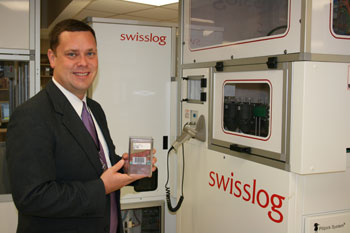 |
Chris Shaffer, director of pharmaceutical and nutrition care at The Nebraska Medical Center and adjunct professor in the UNMC College of Pharmacy, with The Nebraska Medical Center’s new Swisslog PillPick system. |
It’s the Swisslog PillPick system, an automated drug management unit, designed to package, store and dispense medications in bar coded, unit-dose form. It has the capability of storing 44,000 medication unit doses. The Nebraska Medical Center — UNMC’s hospital partner — dispenses more than 6,000 unit doses daily.
“Less than 1 percent of acute care hospitals in North America have this technology,” said Mike Powell, executive director of pharmacy and pathology services at The Nebraska Medical Center. “The Nebraska Medical Center is fortunate to have such state-of-the-art technology. This system will definitely help eliminate possible medication errors.”
Automated packaging and dispensing systems for filling patient orders are becoming more common in U.S. hospitals as a result of increased public knowledge related to medication errors. The Institute of Medicine reports that more than 7,000 deaths result from medication errors in our country alone. While some of the medication errors result from incorrect orders and transcriptions, almost half of the medication errors occur because of dispensing errors or administration errors.
|
|
“Accurate dispensing is key to patient safety and automatic picking based on bar code recognition assures us of that. The robot also offers compact and efficient storage,” Powell said. “Additionally, bar codes will help our hospital make sure that the doctors and nurses are administering the right drugs at the appropriate dosages.”
According to a Veterans Administration-authored article published in the Journal of Healthcare Information Management in 2002, the Colmery O’Neil VA Medical Center in Topeka, Kan., reported bar code implementation decreased the following error types:
- Wrong medication by 75 percent;
- Wrong dose by 62 percent;
- Wrong patient by 93 percent;
- Wrong administration time by 87 percent; and
- Missed doses by 70 percent.
“The reduction of medication errors has an obvious patient impact and has a financial benefit too,” Powell said. “As a general rule, each adverse drug event due to medication errors can add more than $5,800 to the hospital bill of a single patient.”
The cost stems from factors including increased hospital stays, drugs used to counteract incorrect dosages, and extra nursing and physician costs, Powell said.
A critical component to bar code implementation happens at a patient’s bedside. In a typical administration cycle utilizing bedside verification, a nurse will scan the bar code on the unit dose and scan the patient’s wristband in order to ensure that the “five rights” are met: right patient, right drug, right dose, right route and right time.
The nurse also will scan the bar code on her hospital identification badge to record who administered the drug.
Dawn Straub, director of nursing resources and development at The Nebraska Medical Center said it is vitally important that pharmacy and nursing work closely together.
“Nurses are at the sharp end of patient care delivery — that point where all preceding work and actions of others culminate into actual intervention to the patient,” she said. “Bar coding will help provide patient safety at this point of interaction, and give the nurse a safety net.”
Another safety feature of the PillPick system is full automation. After a pillbox is filled and verified by the pharmacist, the doses dispensed are not touched by human hands until they are given to the patient. A pillbox contains up to a three-month supply of commonly dispensed pharmaceutical drugs.
“Simply put, the more human intervention, the greater the probability for error. This automated system minimizes handling by pharmacy staff, reducing the potential for human error,” Powell said.
The ‘robot’ has been operational at The Nebraska Medical Center for a month now.
“Already, the pharmacy staff is seeing amazing results,” said Chris Shaffer, director of pharmaceutical and nutrition care at The Nebraska Medical Center and adjunct professor in the UNMC College of Pharmacy. “One big difference is the phones aren’t constantly ringing in the pharmacy anymore because nurses aren’t calling about missing medication doses. We estimate the system will eliminate about 17,000 phone calls a year.”
The system also eliminates the tedious and time-consuming task of handling and packaging unit dose medications. Shaffer said. This frees up pharmacists to spend more time consulting with physicians and nurses about patient care.
“Research shows that when pharmacists round with physicians, medication errors are reduced by up to two-thirds,” Shaffer said.